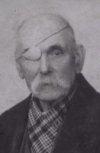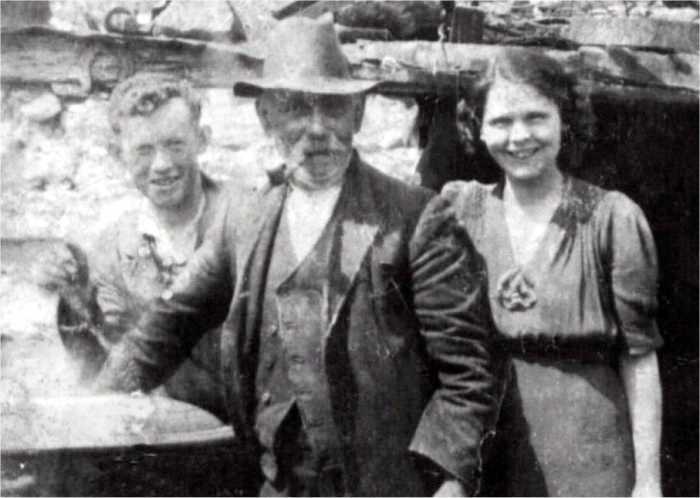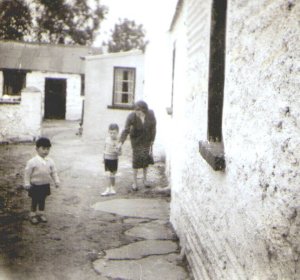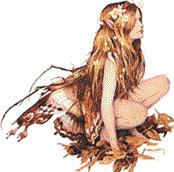 My earliest memory is of my maternal great-grandmother, Grandma Quinn, sitting in front of an open-hearth fire with two side hobs and a great iron crook from which a large black kettle was suspended over glowing turf sods. She was sitting in a rocking chair with her feet, in black lace-up boots, on a footstool. She wore a long black shawl, with a white bonnet tied under her chin. I don't remember what she looked like other than that she was small and thin. She may have been smoking a clay pipe. I now know that she was then 102 years old, having been born in 1838, not far from where she was sitting, exactly a century before I entered the world.
My earliest memory is of my maternal great-grandmother, Grandma Quinn, sitting in front of an open-hearth fire with two side hobs and a great iron crook from which a large black kettle was suspended over glowing turf sods. She was sitting in a rocking chair with her feet, in black lace-up boots, on a footstool. She wore a long black shawl, with a white bonnet tied under her chin. I don't remember what she looked like other than that she was small and thin. She may have been smoking a clay pipe. I now know that she was then 102 years old, having been born in 1838, not far from where she was sitting, exactly a century before I entered the world.
Grandma Quinn lived with her son Paddy - my granduncle - about half way between our house and Granda Boyle's. It stood alone on a rocky outcrop, with straggly trees on two sides partly surrounded by a boggy field that was well below the level of the hillock and the adjoining road. There were a few acres of farmland that provided a meagre living for the two of them. All around, south Armagh was a landscape of hills, bogs and lakes, with the Carrive Mountain, the most westerly outcrop of Ring of Gullion, forming a natural rampart to the east.
Uncle Paddy was small. He had no teeth, little hair and he smoked a clay pipe. He had a muffled singsong voice and he had a distinctive aroma about him, a mixture of tobacco and turf smoke, and other substances I was never able to identify. The recollection of that smell evokes a dim picture of that first light (great-grandma Quinn in her shawl and bonnet).

 My mother was fifth of a family of ten. Her parents had a small farm (also still in the family) in Tullydonnell, on the Armagh/Louth border. Like granda Devlin, granda Boyle supplemented the income from the farm by taking outside employment from time to time. For a time he was known as "The roadman Boyle" as he had a contract with the County Council to keep the roads in repair. He also leveled the ground for the construction of a new Chapel at Glassdrummond. Another of his contracts involved reducing the gradient on the road between the Dundalk-Newtownhamilton road and Silverbridge at Legmoylin. During this job, in the 1930s, he lost an eye in an accident. He had a glass eye but seldom wore it and for the most part went around with an eye patch that, in combination with a bald head and luxurious moustache, gave him the exotic appearance of a pirate.
My mother was fifth of a family of ten. Her parents had a small farm (also still in the family) in Tullydonnell, on the Armagh/Louth border. Like granda Devlin, granda Boyle supplemented the income from the farm by taking outside employment from time to time. For a time he was known as "The roadman Boyle" as he had a contract with the County Council to keep the roads in repair. He also leveled the ground for the construction of a new Chapel at Glassdrummond. Another of his contracts involved reducing the gradient on the road between the Dundalk-Newtownhamilton road and Silverbridge at Legmoylin. During this job, in the 1930s, he lost an eye in an accident. He had a glass eye but seldom wore it and for the most part went around with an eye patch that, in combination with a bald head and luxurious moustache, gave him the exotic appearance of a pirate.
My grandparent's farm was a special place for me and I was always welcome there, as were all of their grandchildren, who were to grow to nearly fifty in number. It was known as "The Hill" and where we met many of our cousins "The Hill" was a magical place where there was an endless series of interesting features and activities to hold our attention.  It was a working farm with cows, pigs and horses. The pigs were fed on a mash made of boiled potatoes, buttermilk and meal. The potatoes were prepared in a huge iron pot set in bricks above a fire and covered with an enormous lid. A spigot allowed the boiling water to be drained away when cooking was complete. The smell of boiling potatoes was wonderful. A mountain of potatoes bursting from their skins, begging to be eaten, confronted one when the water was drained and the lid removed, and often the pigs went one or two short. Then the buttermilk and meal was added and all was mashed together, ready to be transferred by bucket to the sty. Of course the pigs were conscious of the pending food as soon as the potatoes began to boil and put up the most fearful racket, squealing and grunting, rising to a crescendo as the preparation neared completion and then climbing over each other in their eagerness to get to it when it was delivered to the troughs.
It was a working farm with cows, pigs and horses. The pigs were fed on a mash made of boiled potatoes, buttermilk and meal. The potatoes were prepared in a huge iron pot set in bricks above a fire and covered with an enormous lid. A spigot allowed the boiling water to be drained away when cooking was complete. The smell of boiling potatoes was wonderful. A mountain of potatoes bursting from their skins, begging to be eaten, confronted one when the water was drained and the lid removed, and often the pigs went one or two short. Then the buttermilk and meal was added and all was mashed together, ready to be transferred by bucket to the sty. Of course the pigs were conscious of the pending food as soon as the potatoes began to boil and put up the most fearful racket, squealing and grunting, rising to a crescendo as the preparation neared completion and then climbing over each other in their eagerness to get to it when it was delivered to the troughs.
 An enormous hayrick dominated the haggard. It was held in place by twisted ropes made from the hay itself with a tool turned by hand while the hay was fed to it out of the rick by a second person. The ropes looped over the rick and were secured to rope ends created for this purpose on the other side. When hay was needed for the cattle it was cut out with a large hay knife. This had a blade as long as a scythe, without the curve, and a long wooden handle.
An enormous hayrick dominated the haggard. It was held in place by twisted ropes made from the hay itself with a tool turned by hand while the hay was fed to it out of the rick by a second person. The ropes looped over the rick and were secured to rope ends created for this purpose on the other side. When hay was needed for the cattle it was cut out with a large hay knife. This had a blade as long as a scythe, without the curve, and a long wooden handle.
Swedes were also used to feed the cattle. These were cut up in a big iron machine standing on four legs with a hopper for the swedes and a rotary cutter operated by turning an iron wheel with a wooden handle. I loved working the machine although it was hard work, especially when several swedes at once jammed the cutter.
My grandparent's house was joined to one occupied by the Murphy family. There was Mickel, his wife Nelly, two girls, Kitty and Gerty, and one son, Patsy. The families were related; my great-grandfather's wife was Mickel Murphy's aunt. Their nickname was Tight to distinguish them from the many other families of Murphys in the area.
Part of the farm lay on the other side of the Newtownhamilton/Dundalk Road up a lane bounded by high hawthorn hedges. This part of the farm was known as Dan Reels. There was a derelict house which had been occupied by a Dan Reel who had killed his wife and then cut his own throat. I didn't know the date this was supposed to have happened but it must have been some decades before we started to pass the house on our way across the fields from Ballsmills to granda's house. My uncle Tommy remembers seeing, when a boy, the double funeral coming from the house. I do recall the frisson of fear as we passed quickly by. For more information see Tullydonnell Tragedy. In a field beside the lane a bull was kept and we were always cautious and quiet when passing it. I remember one occasion when Kathleen and I, coming down the lane, encountered the bull quietly grazing in the lane. I quickly pushed Kathleen over the ditch through a hole in the hedge and we continued through the field to the main road.
Near to the farm was a ring fort. This was a rath, one of thousands scattered over the north of Ireland, and built by the early settlers as protection for people and animals, continuing in use until about a thousand years ago. There was no lane to it so it had be approached over fields. As we neared it, its appearance was of a wide, bush covered mound on top of the hill. There was a single opening. Once through the entrance there was a clearing about 50 yards in diameter surrounded by a rampart about five feet in height. On the other side of this rampart was a ditch some twelve feet deep with an outer rampart of the same height . Thick hawthorn bushes and trees covered the ramparts while the centre of the fort remained clear. Sited on one of the highest hills in the area, with a clear view to Dundalk Bay, it was well placed to give early warning of danger and for effective protection for the early settlers of the area.


To us children however it was the fairy fort and when we visited it we did so with excitement and not a little fear. Granda had us well primed with his stories about the fairies and their antics and the way that it was their custom to kidnap children and bring then under the hill where they might spend many years before being released. We were warned never to sleep in there, or to dig it up or to damage the bushes. There were stories about fairy lights and fairy celebrations on nights of the full moon. It was on such nights that one had to be extra careful since the music would enchant you and lead you to enter the fort to be enslaved by the fairies there. Rings of toadstools, common enough where cows grazed, were where the fairies had danced. We were familiar with Yeates' poem The Stolen Child" and Allingham's "The Fairies" and believed explicitly in the reality of fairyland. When we were there we felt the nearness of the supernatural. Magic was close and could surprise you at any minute. We wondered what would happen if we saw a fairy. Our vision of them was more akin to goblins and leprechauns than dainty winged creatures and every time we went there we half expected to encounter one under a toadstool cobbling shoes.
Returns from the Census of Ireland 1901 show that the farm was occupied by my great grandfather John (aged 69)and his wife Jane (aged 70) Boyle and their son John (my grandfather) (age 40). It records that both John and Jane spoke both Irish and English - John (Jr) spoke only English. In the 1911 Census the family has been increased. John is now married to Mary and there are four children - Jane (aged 4), Felix (3), John (2) and Patrick (1). John and Jane had been married for 52 years. There are some differences in the ages recorded compared with the 1901 Census.